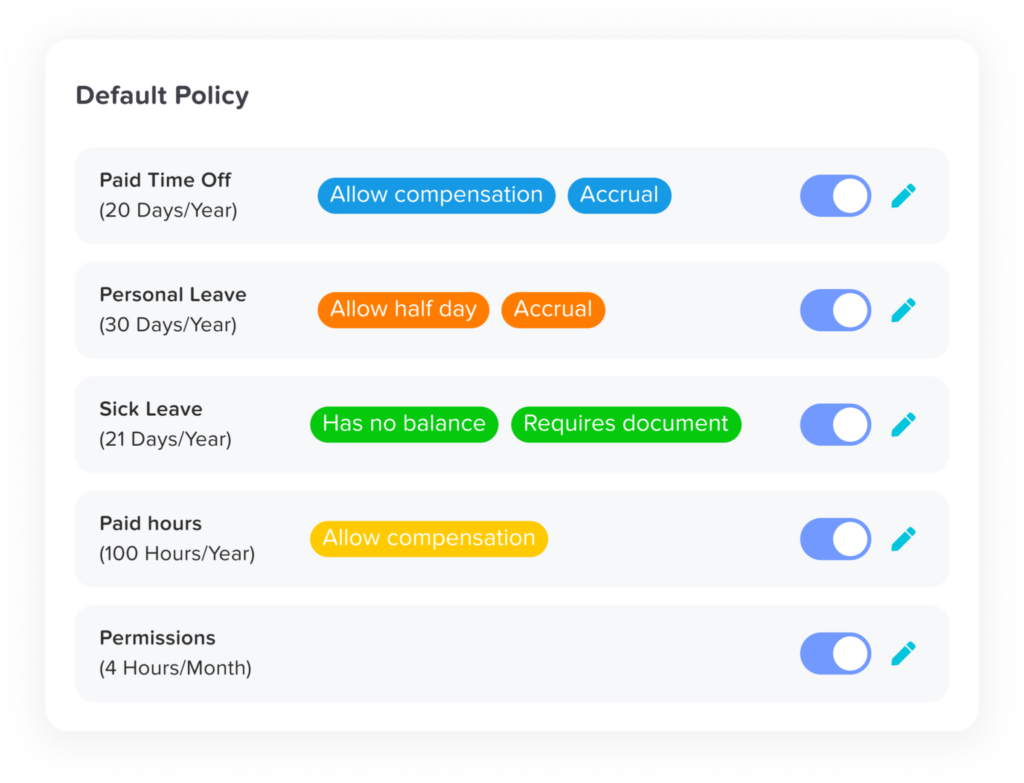Table of Contents
ToggleWorkers in every industry occasionally fall ill, making sick days an inevitable part of the professional landscape. While some employees can take time off to recover, others may feel compelled to show up to work despite being unwell. In the United States, companies offer varying amounts of sick leave—ranging from a few days to flexible paid time off (PTO) policies.
In this article, we’ll explore how ill times are allocated and used in the U.S., their impact on businesses, and why having a clear sick leave policy is essential for organizations.
How Many Sick Days Per Year Are American Workers Allocated?
Sick leave availability differs depending on workplace policies, industry standards, and state regulations. It’s also influenced by broader factors like public health crises. For instance, during the COVID-19 pandemic, many workers needed extended sick leaves to recover or care for family members, significantly affecting averages.
Beyond external factors, the number of sickness leave a worker is allocated often depends on their employer’s discretion and compliance with state laws. Let’s examine the two main types of sick leave policies: unpaid and paid.

Unpaid Sick Leave
The Family and Medical Leave Act (FMLA) provides a safety net for many workers who need extended time off due to serious illness or family responsibilities. While this policy protects employees’ jobs during their absence, it does not guarantee income, leaving workers in a difficult position if they can’t afford unpaid time off.
Key Features of FMLA:
- Eligibility Requirements: Not all employees qualify for FMLA. Workers must have at least one year of tenure, worked 1,250 hours in the past year, and be employed at a company with 50 or more workers within 75 miles.
- Versatility: FMLA covers personal illness, caring for an ill family member, or bonding with a new child.
While FMLA ensures job security, its lack of wage replacement underscores the importance of paid sick leave options for employees who cannot afford to go without pay.
Paid Sickness Time Leave
Some states go beyond the federal FMLA requirements by mandating paid sickness leave. These policies offer employees much-needed financial stability during illnesses and encourage them to stay home when unwell, reducing the spread of contagious diseases.
Examples of State-Mandated Paid Sick Leave:
- California: Workers receive 3 days (24 hours) of paid sick leave annually.
- Connecticut: Employees are eligible for up to 40 hours of paid sick leave.
- Other States: States like Oregon, New Jersey, and Massachusetts have also implemented similar laws to protect workers.
Beyond these mandates, many employers voluntarily offer paid sick leave. According to a 2022 SHRM report, 96% of employers provide some form of paid sick leave. The Bureau of Labor Statistics (BLS) also reported that 79% of civilian workers (non-government and non-agricultural employees) have access to paid sick leave.
Breakdown by Sector:
- Public Sector: Nearly all public school teachers (99%) and full-time local and state government workers (99%) have access to paid sick leave.
- Private Sector: About 77% of private-sector employees receive paid sick leave, but part-time workers are significantly less likely to have this benefit.
Paid sick leave plays a critical role in fostering a healthy workforce and preventing presenteeism—where sick employees come to work and risk spreading illness to others.
Average Sickness Days Allocated by Tenure and Company Size
The number of sickness time employees can access often depends on their length of service and the size of their employer.
- After 1 year of service: Workers typically receive an average of 7 sick leave annually.
- After 20 years of service: This figure increases slightly to 8 days per year.
Impact of Company Size:
- Larger Companies: Businesses with over 500 employees tend to offer more generous sick leave benefits, with employees receiving an average of 9 days after 5 years and 10 days after 20 years.
- Smaller Companies: Companies with fewer than 50 employees often provide only 6 days after 1 year and 7 days after 20 years.
These variations highlight the influence of organizational resources and priorities on sick leave policies.
Paid Time Off (PTO) Policies
Some organizations take a more flexible approach to time off by offering Paid Time Off (PTO) policies. PTO allows employees to use their allotted days for any reason, including vacations, personal matters, or illness.
Types of PTO Policies:
- Limited PTO: Employees are given a set number of days, which they can use throughout the year. Some policies allow unused PTO to roll over into the following year, offering added flexibility.
- Unlimited PTO: Companies like Netflix and LinkedIn offer unlimited PTO, where employees can take as much time off as they need, provided they meet their job responsibilities. While attractive in theory, these policies often come with unwritten norms about acceptable usage.
In addition to standard PTO, some companies offer mental health days to help employees prevent burnout and manage stress. These proactive policies signal a commitment to employee well-being.
How Many Sickness Days Do American Workers Take?
Despite having access to sick leave, many workers don’t use their full allocation.
- A 2022 Statista survey found that 26% of employees took no sick time, while 15% took just 1-3 days.
- A separate study of hourly workers revealed that 65% of employees worked while sick during three months in 2021.
Why Workers Avoid Taking Illness Leave:
- No Paid Leave: Many workers (30%) lack access to paid sick days.
- Financial Constraints: Over half (55%) said they couldn’t afford to miss work.
- Shift Coverage Issues: 40% reported difficulty finding someone to cover their shift.
- Fear of Repercussions: 44% worried they might face penalties for calling in sick.
These findings highlight the need for supportive sick leave policies that allow workers to prioritize their health without fearing financial or professional consequences.
Why Does the Average Number of Sickness Days Matter?
The number of sick time offered and used in a workplace has far-reaching implications for employees and employers.
- Attracting Top Talent: Generous illness leave policies enhance an organization’s reputation and make it more attractive to skilled workers.
- Preventing Illness Spread: Encouraging sick employees to stay home reduces workplace outbreaks of contagious diseases, improving overall productivity.
- Boosting Employee Well-Being: Providing adequate time off for recovery helps employees return to work healthier and more focused.
- Supporting Longevity: Studies show that paid sick leave can improve worker health and even reduce mortality rates.
Creating a Sickness Leave Policy
To implement an effective sick leave policy, organizations should:
- Understand Legal Requirements: Comply with FMLA and state laws while consulting legal experts to avoid pitfalls.
- Evaluate Budget and Competition: Strive to match or exceed industry standards without straining company resources.
- Communicate Clearly: Educate employees on how to report absences and request sick leave.
- Use Technology: Tools like time-off trackers and shift management apps can streamline absence management.
- Prepare for Last-Minute Absences: Establish protocols for covering shifts and redistributing work when employees call in sick unexpectedly.
Conclusion
On average, American workers have access to 7-8 sick time annually, but many don’t fully utilize this time. By implementing thoughtful, flexible illness leave policies, employers can foster a healthier and more productive workforce while reinforcing their commitment to employee well-being.
A well-designed sick leave policy is not just an operational necessity—it’s a critical investment in any organization’s success and resilience.
